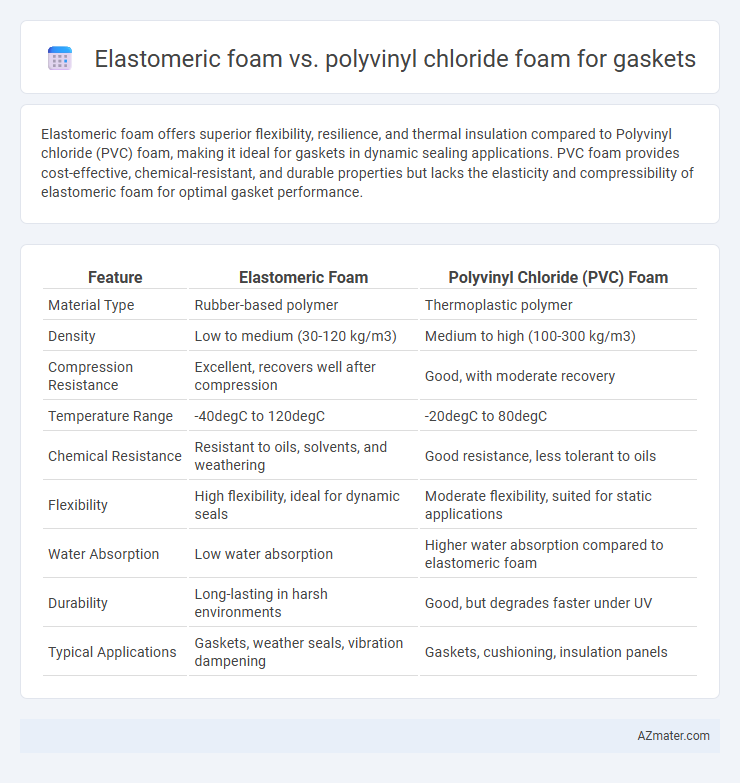Elastomeric foam offers superior flexibility, resilience, and thermal insulation compared to Polyvinyl chloride (PVC) foam, making it ideal for gaskets in dynamic sealing applications. PVC foam provides cost-effective, chemical-resistant, and durable properties but lacks the elasticity and compressibility of elastomeric foam for optimal gasket performance.
Table of Comparison
| Feature | Elastomeric Foam | Polyvinyl Chloride (PVC) Foam |
|---|---|---|
| Material Type | Rubber-based polymer | Thermoplastic polymer |
| Density | Low to medium (30-120 kg/m3) | Medium to high (100-300 kg/m3) |
| Compression Resistance | Excellent, recovers well after compression | Good, with moderate recovery |
| Temperature Range | -40degC to 120degC | -20degC to 80degC |
| Chemical Resistance | Resistant to oils, solvents, and weathering | Good resistance, less tolerant to oils |
| Flexibility | High flexibility, ideal for dynamic seals | Moderate flexibility, suited for static applications |
| Water Absorption | Low water absorption | Higher water absorption compared to elastomeric foam |
| Durability | Long-lasting in harsh environments | Good, but degrades faster under UV |
| Typical Applications | Gaskets, weather seals, vibration dampening | Gaskets, cushioning, insulation panels |
Introduction to Gasket Materials
Elastomeric foam offers superior flexibility and resilience, making it ideal for gaskets requiring excellent compression set resistance and airtight sealing. Polyvinyl chloride (PVC) foam provides durability and chemical resistance, suited for gaskets exposed to harsh environmental conditions and moderate mechanical stress. Choosing between elastomeric and PVC foam depends on application-specific factors such as temperature range, chemical exposure, and required sealing performance.
Overview of Elastomeric Foam
Elastomeric foam offers superior flexibility, resilience, and thermal insulation compared to Polyvinyl chloride (PVC) foam, making it ideal for gaskets in dynamic sealing applications. Its closed-cell structure provides excellent moisture resistance and compression set recovery, ensuring long-term durability under varying temperature and pressure conditions. Common elastomeric materials include neoprene, EPDM, and silicone, each contributing unique chemical resistance and elasticity for diverse industrial uses.
Overview of Polyvinyl Chloride (PVC) Foam
Polyvinyl Chloride (PVC) foam is a closed-cell, lightweight material known for its excellent chemical resistance, durability, and low water absorption, making it ideal for gasket applications requiring reliable sealing in harsh environments. Its high tensile strength and resistance to oils, solvents, and UV radiation provide long-lasting performance compared to elastomeric foams, which may degrade faster under similar conditions. PVC foam's versatility in hardness and density customization allows for tailored gasket solutions with enhanced compression set resistance and dimensional stability.
Physical and Mechanical Properties Comparison
Elastomeric foam exhibits superior flexibility and resilience compared to polyvinyl chloride (PVC) foam, making it ideal for applications requiring frequent compression and recovery in gaskets. PVC foam offers higher tensile strength and better chemical resistance, but its rigidity limits deformation under pressure. Both materials provide effective sealing, yet elastomeric foam's enhanced compressibility and durability deliver improved performance in dynamic sealing environments.
Chemical Resistance and Durability
Elastomeric foam exhibits superior chemical resistance against oils, solvents, and acids compared to polyvinyl chloride (PVC) foam, making it ideal for harsh industrial gasket applications. Its resilient cellular structure provides enhanced durability and maintains flexibility under extreme temperatures, whereas PVC foam tends to degrade and lose integrity sooner when exposed to aggressive chemicals. Choosing elastomeric foam for gaskets ensures prolonged service life and reliable sealing performance in chemically demanding environments.
Thermal and Acoustic Insulation Capabilities
Elastomeric foam offers superior thermal insulation due to its closed-cell structure that effectively reduces heat transfer, making it ideal for gasket applications requiring temperature resistance. Its open-cell vinyl foam counterpart provides moderate acoustic absorption but generally lacks the thermal performance of elastomeric foam. When prioritizing both thermal and acoustic insulation, elastomeric foam gaskets deliver enhanced durability and insulating efficiency compared to polyvinyl chloride foam alternatives.
Application Suitability in Various Industries
Elastomeric foam offers superior flexibility, resilience, and excellent thermal insulation, making it ideal for automotive, HVAC, and aerospace gasket applications requiring vibration dampening and temperature resistance. Polyvinyl chloride (PVC) foam provides robust chemical resistance and durability, preferred in plumbing, electrical, and construction industries where exposure to moisture, oils, and environmental contaminants is prevalent. Selecting between elastomeric and PVC foams depends on specific industry demands such as temperature range, chemical exposure, and mechanical stress tolerance.
Environmental Impact and Sustainability
Elastomeric foam used in gaskets offers superior environmental benefits due to its recyclability and lower toxicity compared to polyvinyl chloride (PVC) foam, which often contains harmful additives such as plasticizers and chlorine, contributing to hazardous waste and pollution. Elastomeric materials typically have a longer lifespan and better chemical resistance, reducing the frequency of replacement and minimizing overall resource consumption. The manufacturing process for elastomeric foam also tends to generate fewer volatile organic compounds (VOCs) and greenhouse gas emissions than PVC foam production, enhancing its sustainability profile.
Cost and Availability Analysis
Elastomeric foam offers superior flexibility and resilience at a moderate cost, often favored for gaskets requiring high compression set resistance and weatherability; however, its availability can be limited in specialty grades. Polyvinyl chloride (PVC) foam provides a cost-effective solution with widespread availability and excellent chemical resistance, making it suitable for applications where budget constraints and mass production are priorities. The choice between elastomeric and PVC foam gaskets hinges on balancing long-term performance benefits against initial material expense and regional supply chain factors.
Conclusion: Choosing the Right Foam for Gasket Applications
Elastomeric foam offers superior flexibility, excellent compression set resistance, and better sealing performance in dynamic gasket applications, making it ideal for environments requiring repeated compression and recovery. Polyvinyl chloride (PVC) foam provides cost-effective durability and chemical resistance, suitable for static seals and less demanding applications where budget constraints are critical. Selecting the right foam depends on the specific pressure, temperature, and chemical exposure requirements of the gasket application to ensure optimal performance and longevity.

Infographic: Elastomeric foam vs Polyvinyl chloride foam for Gasket
 azmater.com
azmater.com